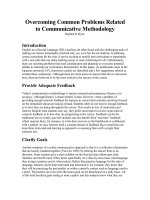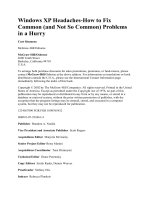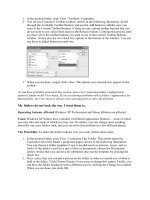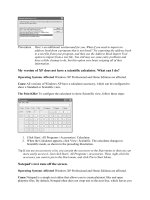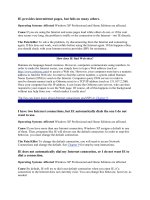Overcoming Common Problems Related to Communicative Methodology
Bạn đang xem bản rút gọn của tài liệu. Xem và tải ngay bản đầy đủ của tài liệu tại đây (82.82 KB, 4 trang )
Overcoming Common Problems Related
to Communicative Methodology
Stephen B. Ryan
Introduction
English-as-a-Second Language (ESL) teachers are often faced with the challenging tasks of
making our classes meaningful, practical and, yes, even fun for our students. In planning
course curriculum for the year, it can be exciting to modify past curriculum or experiment
with a new plan that can make teaching easier or more interesting for all. Unfortunately,
there are recurring problems that need consideration and planning to overcome potential
pitfalls to realizing our curriculums full potential. In this paper, six problematic areas in the
Japanese university EFL classroom context are identified and a few suggestions offered to
combat these weaknesses. Although there are more areas of concern than the six discussed
here, these are believed to be the most critical to the success of the course.
Provide Adequate Feedback
Today's communicative methodology is learner-centered and emphasizes fluency over
accuracy. Although fluency is much needed, it does, however, create a problem of
providing enough concrete feedback for learners to correct their mistakes and keep focused
on the immediate classroom task(s) at hand. Students often do not receive enough feedback
as to how they are doing throughout the course. This results in loss of motivation and
interest. Despite what students may say, they prefer and expect to receive some kind of
concrete feedback as to how they are progressing in the course. Feedback can be the
traditional test or weekly quiz but students can also benefit from "real time" feedback
which requires them, for instance, to write their answers on the blackboard or collaborate
with a partner. In sum, learners need a constant stream of feedback big or small that can
keep them motivated and learning as opposed to a assessing them with a single final
semester test.
Clarify Goals
Another weakness of a solely communicative approach is that it is a collection of principles
that are loosely bundled together (Van Lier 1988:72) offering the learner little or no
direction. Some teachers give a class syllabus on the first day that seldom gets used.
Students can benefit more if they know specifically on a class-by-class basis what language
they trying to practice and in what context. Rather than practice language for the sake of
language, learners can be kept motivated and interested if, for example, they know that
they will be practicing the past perfect or within a specific context such as language used in
a hotel. The teacher can even write the lesson goal on the blackboard on a daily basis. All
of this kind localized goal setting is more explicit and lets students know what they are
expected to do. In sum, it is useful to set small achievable goals on a daily basis and make
learners aware of how they are to accomplish these goals.
Have Consistency in Teaching Style
Communicative methodology is great for requiring our students to produce language albeit
in a somewhat loose fashion. But, it also creates a division in teaching style. At some
stages, we are expected to be strict about certain aspects such as regular attendance and
punctuality. On the other hand, we often have to assume the role of friend-coach to make
our learners feel compelled to speak and not be afraid of making mistakes. This creates a
stark contrast between the teacher who can fail and the teacher that wishes to encourage
speaking and, necessarily, making mistakes. Learners may feel betrayed if they score
poorly on a test but do well in classroom tasks. As second or foreign language teachers, it
is crucial that we maintain awareness of our "style" of teaching. It often helps to observe a
colleague's class or have a trusted colleague observe your own. You may find some useful
insights into your own lessons. For instance, I once had a colleague observe my own class,
and he observed that I occasionally changed my English grammar to a Japanese grammar
style, "On the blackboard, write your answers please." This usage was inconsistent with the
goals of the course. It may feel uncomfortable to be critiqued or observed. However, if we
do not become more aware of our teaching style and inconsistencies, we will have
difficulty in continuing to grow professionally.
Lessons Need a Routine or Framework
There is a fine line between in communicative methodology between giving students too
much responsibility to speak freely in class and not enough. The communicative approach
in its pure form advocates making students speak as much as possible. However, language
is also a routine and learners need a framework in which they can feel comfortable in
taking that risk to speak out in front of others. A useful framework often presented by
many teacher trainers is:
• Warm-up
• Presentation
• Controlled practice
• Free practice
• Feedback
Many current EFL textbooks adopt this kind of curricula. Below is an example how each
phase can be done in a 90 minute lesson.
Topic: Hotel reservations
Language functions: making reservations, asking, expressing opinion
• Warm-up: The teacher asks students (in pairs) to think of 3 "hotel words" such as
lobby or front desk and write them on the blackboard. The teacher then goes over
each word explaining any difficult points and just trying to frame the context.
• Presentation: Learners listen to a short dialogue between a hotel clerk and
customer. Then, they repeat it with the teacher aloud to raise awareness and
practice pronunciation
• Controlled practice: Students practice the same conversation above substituting
some words if they wish. After 10 minutes, learners close their books and can
volunteer to perform the memorized dialogue. With books still closed, the teacher
plays the same dialogue from the tape again allowing learners to gain additional
confidence.
• Free practice: The teacher gives a hotel information gap exercise to each pair.
Students are now required to freely practice the same language and are sufficiently
empowered to do so.
• Feedback: The teacher goes over any problematic phrases, pronunciation
difficulties or even acts out the drama with the students by changing the dialogue in
"real time".
Have Cultural Awareness
We know that culture plays an important role in the day-to-day classroom activities. It is
important for the teacher to recognize potential negative culturally based perceptions of
their learners and vice versa. In Japan, for instance, it is not uncommon to be met with
silent expressionless students. It is possible for the novice instructor to interpret this
negatively as a lack of interest. This is a cultural interpretation that may play a detrimental
role in classroom methodology. Silence is a cultural value that is relative to Western and
Japanese cultures. Humor, teasing and silence are also highly diverse culturally so the
teacher must be self-aware when using humor or teasing to induce students to perform or
simply react. An instructor does not necessarily have to be interculturally competent to be
an effective teacher however. It may be more effective if the instructor adopts a consistent
style of instruction to allow learners to adapt within the bounds of their own personalities
without being coerced to behave outside their own cultural values.
Be Clear About Student-Teacher Relationship
ESL teachers are often faced with choosing the kind of relationship they wish to establish
with their students. Some prefer a strict division between the student-teacher relationship
while others prefer a friend-coach relationship. Communicative methodology encourages
the latter. Many students misinterpret this as tacit approval to pursue undesirable behavior
such as cutting class or turning in late homework. To avoid this, it is important to clearly
express not only the course requirements but one's own personal philosophy to assessing
learners. For instance, students need to know from the first class that you will not accept
late homework assignments or poor attendance, but that they will be allowed to make up
tests and quizzes. By explicitly stressing this kind of seemingly trivial information, the
teacher can save a lot of valuable class time and create a more productive atmosphere.
Conclusion
In conclusion, by being consistent, explicit and offering immediate feedback, there are
fewer opportunities for learners to consistently misinterpret the goals of a course
curriculum. While a communicative methodology is an excellent tool for increasing
fluency, used exclusively, it also creates recurring problems that need to be addressed and
counterbalanced with different methodology. Overcoming these common recurring
problems that plague our courses can free the instructor to become more creative while
allowing learners to become more competent in the target language.
